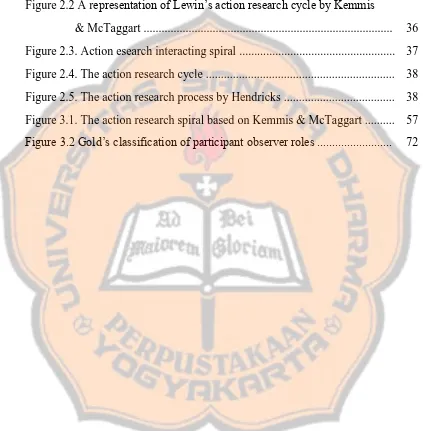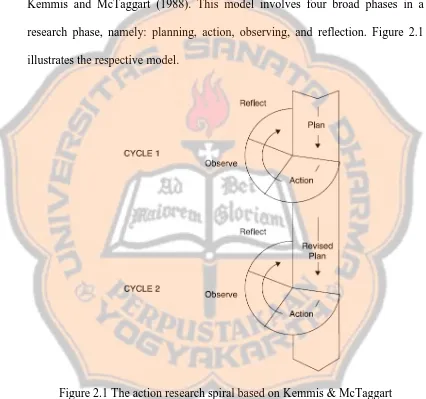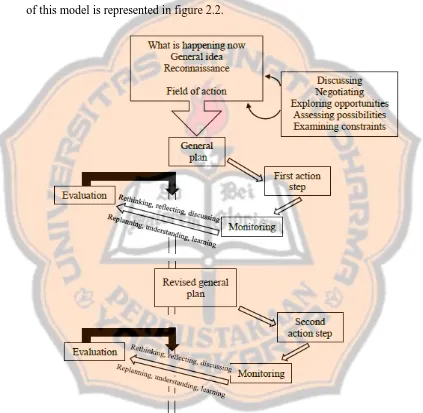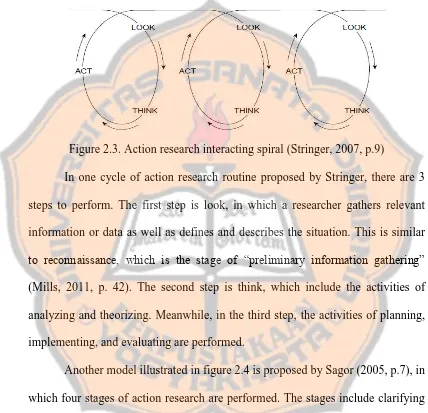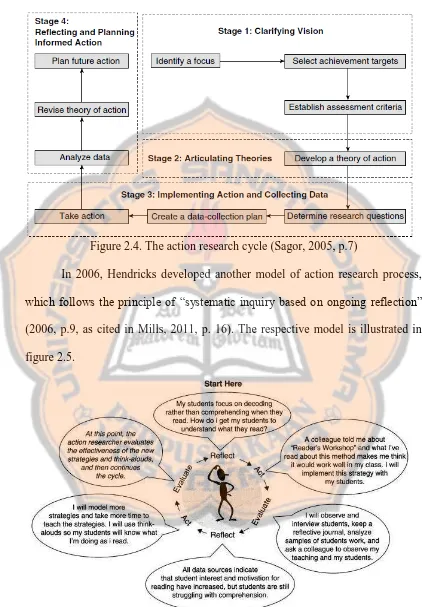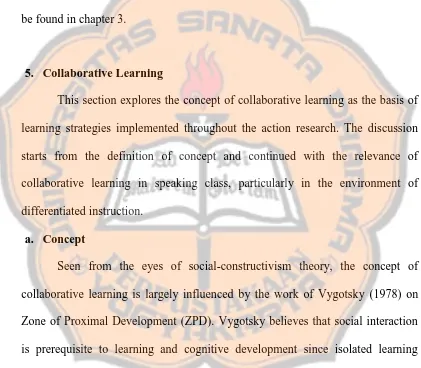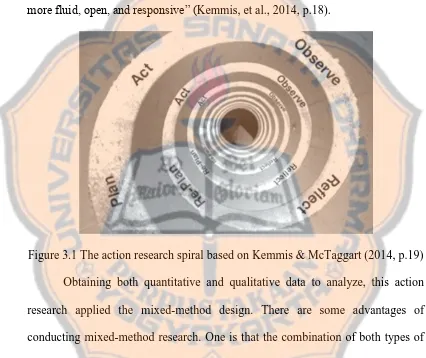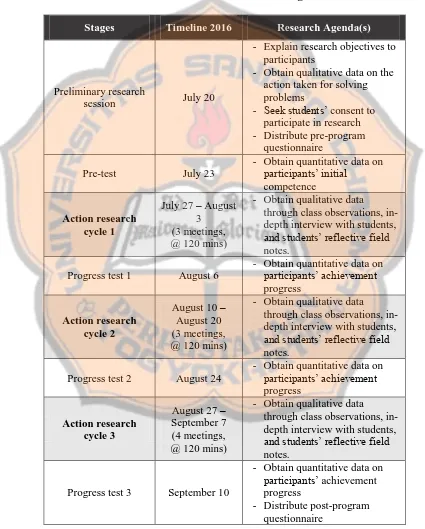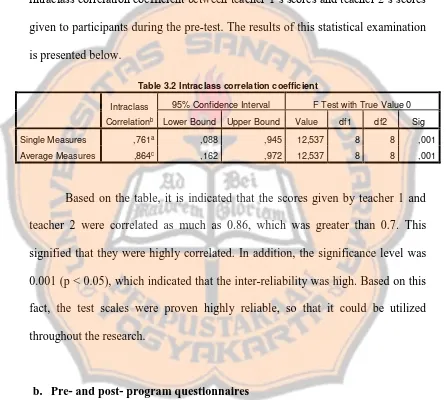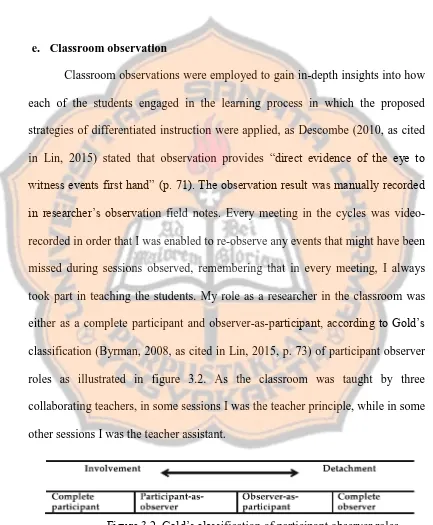INCORPORATING DIFFERENTIATED INSTRUCTION IN
AN ENGLISH SPEAKING CLASS OF MIXED-COMPETENCE
LEARNERS: ACTION RESEARCH
A THESIS
Presented as a Partial Fulfillment of the Requirements to Obtain the Magister Humaniora (M. Hum) Degree
in English Language Studies
by
Rina Astuti Purnamaningwulan Student number: 156332037
THE GRADUATE PROGRAM IN ENGLISH LANGUAGE STUDIES SANATA DHARMA UNIVERSITY
i
INCORPORATING DIFFERENTIATED INSTRUCTION IN AN
ENGLISH SPEAKING CLASS OF MIXED-COMPETENCE
LEARNERS: ACTION RESEARCH
A THESIS
Presented as a Partial Fulfillment of the Requirements to Obtain the Magister Humaniora (M. Hum) Degree
in English Language Studies
by
Rina Astuti Purnamaningwulan Student number: 156332037
THE GRADUATE PROGRAM IN ENGLISH LANGUAGE STUDIES SANATA DHARMA UNIVERSITY
iv
DEDICATION PAGE
This thesis is dedicated to those whom I can never imagine to live
without:
Mamas Andreas
Mami & Bapak
vii
ACKNOWLEDGEMENTS
First and foremost I would like to express my deepest gratitude to God, Lord Jesus Christ for the beautiful life I’m living in, for every breath of fresh air I
can always take, so that I was enabled to endure the ups and downs and series of discouragements during the struggle of completing my thesis.
This thesis also owes its existence to the help, support, and inspiration of
several people. Therefore I would like to thank my thesis advisor, Dr. J. Bismoko for his patience, motivation, enthusiasm, and immense knowledge that he would
share to me. This thesis couldn’t have been completed without his assistance. I would also like to express my gratitude to Mr. F.X. Mukarto, Ph.D. and Dr. E. Sunarto, M.Hum. as my thesis reviewers, as well as Dr. B.B. Dwijatmoko, M.A.
for their valuable feedbacks during the development and revisions of this thesis. My sincere gratitude goes to OMI Novitiate, the institution I owe the most
throughout my data collection period. Special thanks go to Father Santo, Father Yuli, and all the members of OMI Novitiate community who constantly welcome
me every time I paid a visit. I will forever remember the moments I taught my students there and not to forget, the wonderful lunches served by Ibu Christin that we used to enjoy in warm togetherness. Also, I would be forever grateful for
having such wonderful partners like Gisthul and Sindhul who were always there for assisting my teaching as well as coloring my days.
viii
Mochu, the loveliest and most faithful little creature who is always there for me, unconditionally. During the last 27 years I’ve had a place called home with them
surrounding.
Finally, I would like to express my greatest gratitude to the half of my
soul, Andreas Satriawan Kusumanto, who has always been my inspiration and spirit in every inch of step I take in my life; who has been the only one remained when no one else was there for me. Thank you for always standing beside me
even in a distance, to lift me up.
Yogyakarta, 10 May 2017
ix
TABLE OF CONTENTS
TITLE PAGE ... i
APPROVAL PAGE ... ii
DEFENSE APPROVAL PAGE ... iii
DEDICATION PAGE ... iv
STATEMENT OF WORK ORIGINALITY ... v
LEMBAR PERNYATAAN PERSETUJUAN PUBLIKASI KARYAILMIAH UNTUK KEPENTINGAN AKADEMIS ... vi
ACKNOWLEDGEMENTS ... vii
TABLE OF CONTENTS ... ix
LIST OF TABLES ... xiii
LIST OF FIGURES ... xiv
LIST OF APPENDICES ... xv
ABSTRACT ... xvi
ABSTRAK ... xviii
CHAPTER I INTRODUCTION ... 1
A.BACKGROUND ... 1
B.PROBLEM IDENTIFICATION ... 6
C.PROBLEM LIMITATION ... 8
D.RESEARCH PROBLEMS ... 10
E. RESEARCH OBJECTIVES... 10
F. RESEARCH BENEFITS ... 11
CHAPTER II LITERATURE REVIEW ... 13
A.THEORETICAL REVIEW ... 13
1. Postmodern Education ... 13
2. Mixed-Competence Speaking Class ... 18
a. Mixed-competence class ... 18
x
c. Alternatives for teaching mixed-competence speaking class ... 23
3. Differentiated Instruction... 26
a. Basic concept ... 26
b. Teaching strategies... 28
1) Content ... 28
2) Process ... 29
3) Product ... 30
4) Learning environment ... 30
4. Action Research ... 31
a. Definition ... 31
b. Process ... 34
5. Collaborative Learning ... 39
a. Concept ... 39
b. Collaborative learning in speaking class... 42
c. Collaborative learning and differentiated instruction ... 43
6. The Components in Learning Process ... 46
a. Collaboration... 46
b. Autonomy ... 48
B.REVIEW OF RELATED STUDIES ... 50
C.THEORETICAL FRAMEWORK ... 52
CHAPTER III METHODOLOGY ... 55
A.RESEARCH METHOD ... 55
B.RESEARCH DESIGN ... 57
C.RESEARCH SETTING AND PARTICIPANTS ... 62
D.DATA ACQUISITION ... 63
1. Research Question 1 ... 64
2. Research Question 2 ... 65
a. Tests ... 66
b. Pre- and post- program questionnaires ... 69
xi
d. Students’ Reflective Journal ... 71
e. Classroom observation ... 72
E. DATA ANALYSIS AND INTERPRETATION ... 73
1. Research Question 1 ... 73
2. Research Question 2 ... 74
a. Quantitative data analysis ... 74
b. Qualitative data analysis ... 75
CHAPTER IV ANALYSIS RESULTS ... 78
A.INCORPORATION OF DIFFERENTIATED INSTRUCTION INTO THE TAKEN ACTION ... 78
B.EFFECTIVENESS OF THE TAKEN ACTION ... 87
1. Teaching and Learning Process throughout the Action Research Cycles ... 88
a. Action research cycle 1 ... 88
1) Planning ... 88
2) Acting and observing ... 90
a) The effectiveness of games in creating fun learning atmosphere ... 91
b) The effectiveness of mixed-competence grouping ... 92
c) The effectiveness of homogeneous-competence grouping... 97
d) Students’ collaborative attitude outside the classroom ... 101
3) Reflecting ... 104
a) Students’ improvements’ during action research cycle 1 ... 105
b) Points to improve in the next cycle ... 108
b. Action research cycle 2 ... 109
1) Planning ... 109
2) Acting, Observing ... 111
a) Coping with students’ inferiority... 112
b) Students’ awareness of different personal competences ... 115
c) Promotion of students’ learning autonomy ... 120
xii
a) Students’ improvements during action research cycle 2 ... 124
b) Points to improve in the next cycle ... 128
c. Action research cycle 3 ... 130
1) Planning ... 130
2) Acting and observing ... 135
a) Coping with students’ low motivation ... 136
b) Students’ performance in collaborative learning environment ... 142
c) Students’ performance in terms of achieving the course goal ... 144
d) Improvement on students’ learning autonomy ... 151
3) Reflecting ... 158
2. Improvements in Students’ Learning Achievements and Collaboration Skills ... 161
CHAPTER V CONCLUSIONS, IMPLICATIONS, RECOMMENDATIONS ... 166
A.CONCLUSIONS ... 166
B.IMPLICATIONS ... 169
C.RECOMMENDATIONS ... 171
BIBLIOGRAPHY ... 173
xiii
LIST OF TABLES
Table 3.1. Research timeline and agendas ….………... 61
Table 3.2. Intraclass correlation coefficient... 69
Table 3.3. Data coding guideline ... 76
Table 4.1. Students’ responses to questionnaire item 19 ………..… 152
Table 4.2. Students’ responses to questionnaire item 20 ………..… 153
Table 4.3. Students’ responses to questionnaire item 21 ……....……..… 154
Table 4.4. Students’responses to questionnaire item 22 ………..… 155
Table 4.5. Descriptive statistics of pre- and post- program questionnaire responses ... 162
Table 4.6. Wilcoxon signed-ranked test statistics ... 162
Table 4.7. Tests of normality ... 163
Table 4.8. Descriptive statistics of speaking test result ... 164
xiv
LIST OF FIGURES
Figure 2.1 The action research spiral based on Kemmis & McTaggart ... 34
Figure 2.2 A representation of Lewin’s action research cycle by Kemmis & McTaggart ... 36
Figure 2.3. Action esearch interacting spiral ... 37
Figure 2.4. The action research cycle ... 38
Figure 2.5. The action research process by Hendricks ... 38
Figure 3.1. The action research spiral based on Kemmis & McTaggart ... 57
xv
LIST OF APPENDICES
Appendix A. Permit Application Letter ... 182
Appendix B. Reference Letter from Omi Congregation ... 184
Appendix C. Research Program Plan 2016 ... 186
Appendix D. Students’ Consent Letter ... 189
Appendix E. Students’ Handbook ... 192
Appendix F. Speaking Test Specification ... 199
Appendix G. Speaking Test Scoring Sheet ……… 207
Appendix H. Pre-program Questionnaire ……….. 210
Appendix I. Post-program Questionnaire ……….. 213
Appendix J. Interview Guideline Questions ... 217
Appendix K. Reflective Journal Guideline for Cycle 1 and 2 ………... 219
Appendix L. Reflective Journal Guideline for Cycle 3 ………. 222
Appendix M. Students’ Speaking Test Scores ... 225
Appendix N. Pre-program Questionnaire Responses ……… 227
Appendix O. Post-program Questionnaire Responses ………... 231
Appendix P. Interview Transcripts ……… 236
Appendix Q. Students’ Reflective Journals ………... 276
Appendix R. Observation Field Notes ………... 313
xvi ABSTRACT
Purnamaningwulan, Rina Astuti. 2017. Incorporating Differentiated Instruction in an English Speaking Class of Mixed-competence Learners: Action Research. Yogyakarta: The Graduate Program in English Language Studies, Sanata Dharma University.
The recent trend of the twenty first century’s postmodern education has encouraged more educational practitioners to perform research that puts the basis on humanity values, rather than the quest of mere efficiency. Interested mostly in individual uniqueness and diversity, this study puts the concern on individual different academic competences in an English speaking class. Under the umbrella of the postmodern education, this study attempted to solve problems in a speaking class composed of mixed-competence learners through the adoption of action research procedures. Two research questions were addressed in this study: 1) Is differentiated instruction incorporated in the action taken to solve the problems in an English speaking class of mixed-competence learners?; 2) How effective is the
action in developing learners’ speaking skills as well as promoting learners’
collaboration skill?
The participants were nine adult students with different linguistic competences, range of ages as well as educational and cultural background studying in a non-formal and non-streamed English speaking course. The mixed-method design participatory action research (Kemmis, et al., 2014) with three research cycles was employed to plan, implement, and refine the teaching strategies based on differentiated instruction (Tomlinson, 1999, 2014) principles, with emphasis on its collaborative learning elements over a two month-period of course with two times two hour duration per week.
To answer the first research question, the problems in the mixed-competence class were solved through a set of action deliberated by all research participants. It consisted of the following strategies: 1) fun learning environment; 2) extensive speaking practices; 3) collaborative learning; 4) differentiated instruction in terms of learning materials and process.
xvii
xviii ABSTRAK
Purnamaningwulan, Rina Astuti. 2017. Incorporating Differentiated Instruction in an English Speaking Class of Mixed-competence Learners: Action Research. Yogyakarta: Program Pasca Sarjana Kajian Bahasa Inggris, Universitas Sanata Dharma.
Tren pendidikan pasca-modern yang sedang marak di abad duapuluh satu telah mendorong para praktisi pendidikan untuk melaksanakan penelitian yang bukan hanya bertujuan untuk mencapai efisiensi, tetapi juga mengedepankan nilai-nilai kemanusiaan. Didasarkan pada banyaknya keunikan yang dimiliki tiap-tiap individu, penelitian ini berfokus pada perbedaan kemampuan akademis individu dalam konteks pelajaran bicara dalam bahasa Inggris. Di bawah payung pendidikan pasca-modern, penelitian ini ditujukan untuk menyelesaikan masalah-masalah yang ada di dalam kelas bicara Bahasa Inggris yang terdiri dari murid dengan kompetensi yang berbeda. Adapun, penelitian ini mengadopsi prosedur penelitian tindakan kelas dalam pelaksanaannya.
Ada dua pertanyaan yang akan dijawab dalam penelitian ini: 1) Apakah differentiated instruction dimasukkan ke dalam tindakan untuk menyelesaikan masalah-masalah yang ada di kelas bicara yang terdiri dari murid dengan berbagai kompetensi berbeda? 2) Seberapa efektifkah tindakan itu dalam rangka mengembangkan kemampuan bicara siswa, maupun menghidupkan sisi kolaboratif siswa?
Peserta penelitian ini adalah sembilan siswa dewasa yang memiliki perbedaan usia, dan juga latar belakang pendidikan serta budaya. Mereka belajar dalam lingkungan kursus bahasa Inggris non-formal dan tidak ada penjurusan. Penelitian tindakan kelas partisipatif dengan desain mixed-method (Kemmis, et al., 2014) yang terdiri dari 3 putaran dipakai sebagai acuan untuk merencanakan, menerapkan, dan menyempurnakan strategi-strategi belajar. Adapun, strategi yang digunakan adalah prinsip-prinsip differentiated instruction (Tomlinson, 1999, 2014), dengan penekanan pada komponen pembelajaran kolaboratif. Kursus bicara Bahasa inggris ini dilaksanakan sebanyak 2x120 menit / minggu, dan berlangsung selama kurang lebih dua bulan.
Untuk menjawab pertanyaan yang pertama, serangkaian tindakan pun dirumuskan untuk memecahkan masalah, yaitu: 1) suasana belajar yang menyenangkan; 2) Praktek bicara ; 3) pembelajaran kolaboratif; 4) differentiated instruction dalam pemilihan materi dan proses belajar.
xix
= 3.78, z = -2.55, p = 0.011), dengan efek yang cukup besar (r = .49). Selain itu, data kualitatif yang diambil dari catatan lapangan, jurnal refleksi siswa, dan wawancara menunjukkan hasil yang relevan dengan perhitungan kuantitatif ini, Maka, sudah terbukti bahwa tindakan yang diambil selama penelitian sangat efektif dalam mengembangkan kemampuan bicara siswa, dan juga menambah kemambuan kolaboratif siswa. Semua ini menunjukkan bahwa proses pemberdayaan siswa membuahkan hasil yang baik untuk proses belajar mereka ke depannya, termasuk membuat mereka lebih mandiri dalam proses belajar itu sendiri.
1 CHAPTER I INTRODUCTION
This chapter discusses the background of the research and provides justifications for undertaking the research. In addition, the research limitations,
problems, objectives, and benefits are elaborated in this chapter also.
A. BACKGROUND
English teachers are faced with different challenges in language classrooms, which sometimes are problematic. These challenges could potentially
raise problems if they are not well improved. In regular English speaking classes more specifically, there are some commonly occurring problems regardless of the level of proficiency and the number of students in the group. Ur (1995, as cited in
Aleksandrzak, 2011, p.39) defined some problems that are commonly found in speaking classes, namely inhibition, having nothing to say, low participation, and
frequent mother tongue use. The occurrences of these typical problems are still frequently reported until nowadays (e.g. Choudhury, 2005; Aleksandrzak, 2011;).
The different level of participation demonstrated by students in speaking
classes has proven that even in regular classrooms which normally consist of homogenous group of students, there is always a case where some students do not
have the same learning pace. Students who have more willingness to speak English may achieve fluency faster than those who do not and vice versa. Students
2
practice. This can be considered as a problem since the slow and fast learners will eventually gain different achievement and fluency. Although in most language
courses learners are normally streamed in different classes according to their level of competence in the target language in order that the teachers can tailor lessons to the students’ ability level, having students with mixed-competence in one class is
inevitable in some cases.
Other than normal classrooms with homogenous students, there are
classrooms consisting of students with heterogeneous learning ability. In general, this kind of class is formed of students with different levels of English mastery
and fluency, as well as readiness in learning. Some education practitioners address this kind of classroom with the term mixed-ability class, which “are considered as a universal phenomenon” (Al-Shammakhi & Al-Humaidi, 2015, p.33).
Mixed-ability classrooms exist because sometimes students are set randomly in a classroom regardless of their attainment and ability levels. The existence of
mixed-ability or heterogeneous classes in several institutions are driven by some unavoidable realities as revealed by Elizondo (2013) that “educational institutions
with language programs differ in registration procedures, each one making its own decisions, and having specific actions and requirements to follow”. In fact, “... not
all institutions have the financial or institutional support necessary to be able to use the appropriate placement / grouping procedures” (p.116).
Embarking from this reality, in the case of language classes, there is
3
Tomlinson (2012 and 2014, as cited in Al-Shammakhi & Al-Humaidi, 2015) believes that some classes might be more multileveled than others. This fact could
well make teaching more challenging for language teachers.
McKeown (2004, as cited in Bremner, 2008) defines mixed-ability class as
a class that consists of a group of average students, able students, as well as students with learning problems. The term ability, however, does not always refer to academic capability. Bremner (2008, p.2) has stated “a mixed ability class does
not only consist of a range of abilities, but also a range of learning styles and preferences”. Through this definition, Bremner suggests that there is a broader
definition for mixed ability. Other than that, a different term is formulated by Elizondo (2013), who addresses the situation as a mixed-proficiency language class, or MPLC which refers to “the situation faced when students with different
language proficiency levels (beginner, intermediate, and advanced) are placed in the same group to receive language instruction” (p.112). This definition, therefore,
considers language proficiency as the only component that is taken into account when dealing with learners’ different ability.
Despite the different terms used to address the respective type of classroom, in this study, the term mixed-competence is used. The term ‘competence’ has a broader definition since the success of language learning process is not only determined by learners’ initial linguistic proficiency and
knowledge or academic capability, but also learning attitudes and other related
4
competence covers not only one’s knowledge, but also skill, and attitude (Mulyasa, 2013). Taken as a package of competence standard, learners’
knowledge, skill, and attitude are developed integratively in the hope that all learners develop holistically as a human being. Those include learners’ cognitive,
affective (spiritual and emotional), and psychomotoric behaviors in the hope that learners are able to compete in the rapid growing global civilization (Fadlillah, 2014).
In accordance with that, the recent trend of postmodern education proposes linear ideas with the values of holistic education in Indonesian curriculum. That
is, to view learning as a constructive process in which learners are an active, autonomous being who are able to form knowledge through interactions with their surroundings (Fahim & Pishghadam, 2009). Besides, in the postmodernist view of
educational context, each learner is regarded as a unique human being who is different from each other. Thus, unlike the modern education that focuses mainly
on cognitive development in order to achieve the highest efficiency and productivity, the concept of competence used in this research is based on the
postmodern values that view a learner as a whole human being who needs to be developed in terms of intellectual, emotional, social, physical, creative or intuitive, aesthetic, and spiritual potentials (Hare, 2010). As it is the fullest
possible development of a person that this study pays attention to, the term ‘mixed-competence’becomes the most suitable term to address learners’ diversity
5
The fact that some learners are placed in a mixed-competence classroom brings a great consequence since Walqui (2000, p.3) asserts that “a basic
educational principle is that new learning should be based on prior experiences and existing skills” (as cited in Joyce & McMillan, 2010, p. 215). This is a
problematic issue since the learners in the class have to achieve the same goal, yet they start from different points. The fact that the learners have different initial English knowledge, skills, and attitude is presumed to raise problems in the
teaching and learning process.
Al-Shammakhi and Al-Humaidi (2015) reported that there have been a
great body of research studying how teachers can deal with mixed competence classes (e.g. Tomlinson, 2001; Westwood & Arnold, 2004; Pham Phu, 2007; Bremner, 2008; Simanova, 2010, as cited in Al-Shammakhi and Al-Humaidi,
2015). However, little attention has been paid to prepare and train teachers on how to cater for classrooms consisting of different competence levels (Bremner,
2008; Al-Shammakhi and Al-Humaidi, 2015). Similarly, not many guidelines have been provided to teachers in order to help them prepare for suitable
adaptation according to students’ needs (Al-Shammakhi and Al-Humaidi, 2015, p.34). Embarking from the above elaborations, this action research aims to solve the problems in a mixed-competence speaking class. Particularly in this action
research, several strategies are taken under the commitment of all research participants in the aim of creating the best learning process complemented with learners’ empowerment to critically reflect upon their study condition as well as
6
are implemented in the aims to facilitate learners to achieve the best learning result as well as to provide EFL teachers with new insights on the most effective
strategies for teaching the respective type of classrooms.
B. PROBLEM IDENTIFICATION
The main goal of this English course is to make students able to speak English for general communication purposes including conversations and oral
presentations in both formal and informal contexts. Thus, every learner is expected to achieve this goal by the end of the course. However, it is presumed
that there will be problems in the teaching-learning process in this mixed-competence classroom. In terms of achievement, some learners may not be able to achieve the course goal the way it is expected as the learners are false beginners
with different initial proficiency: some have sufficient basic English knowledge to start learning while some others do not. Meanwhile, in terms of learning process,
different problems will possibly occur. For stronger students, studying with students with lower proficiency may cause discouragement in learning, as they do
not make as much improvement as they might expect. The weaker students, on the other hands, will find it stressful to learn with more advanced students as they may feel inferior when working alongside with highly proficient classmates
(Joyce & McMillan, 2010). These problems could create issues in learning motivation, which is one of the factors that influence learning outcomes in
7
Besides in the learning process, hindrances are presumed to occur also in the teaching process. In terms of teaching, teachers would possibly find dilemmas
regarding from which point to start the lesson. Other than that, managing learners with different learning pace is another issue. It is certainly dilemmatic when a
teacher teaches a classroom where there are learners who acquire language features fast while others show little or no improvement yet. In other cases, there are learners who finish tasks much earlier than others, and end up doing negative
behaviors or making noises. This classroom management becomes another issue in handling a class consisting of mixed-competence learners. Given these facts,
providing learners with the equal opportunity to learn and succeed becomes even more challenging for the teachers. These problems need to be solved in order that the same problems do not occur continuously.
This action research offers a possible solution to improve the situation through the implementation of learning strategies, which are based on the
principles of differentiated instruction, which has been promoted mainly by Tomlinson since 1999 to the recent years. The learning strategies include
providing students with tiered tasks, menu of activities and putting the students in flexible groupings in order that they can perform collaborative learning. Through the implementation of these, collaborative learning can be promoted and the
8
C. PROBLEM LIMITATION
The problem addressed in this research is limited in order that the study
becomes more focused and clearly directed. As an action research, this study holds the principles that the whole processes are democratic, empowering and
emancipating for all participants, particularly the students. Thus, every decision taken during the research process is from the participants, done by the participants, and dedicated for the participants. The solutions taken as the action
to solve classroom problems therefore come up in a bottom-up process and the researcher plays a role of engaging the participants in deliberation processes and facilitating the dynamics of participants’ problem solving activities. Contrary to
experimental studies, the action taken in this research is not initially planned by the researcher. Instead, it is tentatively proposed to the participants, so that they
can come up to a decision on their own study path.
In addition to that, students’ test scores prior to and subsequent to the
research are not treated as the only indicators of the effectiveness of certain teaching methods on particular groups of learners as it is usually performed in
experimental studies. Rather, test scores are collected at every end of action research cycle in order to monitor and therefore see whether there is progress in students’ learning process and outcomes during and subsequent to the action
implementation. The test scores in this research are used to discover empirical objectivity, yet not to find cause-effect relationships between the problems and
9
Action research is often associated with the attempt to improve students’
learning as well as teachers’ professional development (Creswell, 2012, p.579).
Nonetheless, this research does not put the main concern on teacher’s professional
development. Rather, it concentrates mostly on students’ life quality improvement
particularly in terms of studying English speaking skills.
Another limitation in this study is that the focus of this action research is to explore the overall dynamics of the teaching and learning process during the
action research period. The contents of learning materials are not put into focus since the research is limited to exploring students’ process of learning English
speaking skills in the environment of differentiated instruction and collaborative learning.
After all, due to a number of constraints, this research could not take
random sampling technique. Rather, purposive sampling is applied since the participant group is given purposively. Besides, the participants acting as the
research samples come in small number, which are nine students. Those students are also the members of a religious institution where their daily activities are
arranged in tight daily schedules. Combined with having two meetings per week, not to mention having to write regular reflection journals, the students might not have quite a long time to prepare themselves for the coming classes or tests, which
might make them unable to demonstrate the best of themselves. Because of this time constraint also, students’ maximum contribution might not be optimally dug
10
D. RESEARCH PROBLEMS
There are two research questions addressed in this research, namely:
1. Is differentiated instruction incorporated in the action taken to solve the problems in an English speaking class of mixed-competence learners?
2. How effective is the action in developing learners’ speaking skills as well as promoting learners’ collaboration skill?
E. RESEARCH OBJECTIVES
Classes composed of mixed-competence learners have a number of
problems, particularly in terms of ensuring the teaching and learning processes run smoothly so that optimal learning outcomes can be yielded. Action research aims at improving an encountered situation through appropriate action carried out
through the empowerment of all research participants in order to enhance “the quality of people’s organizations, communities, and family lives” (Stringer, 2007,
p.10). Therefore, it takes all participants’ contributions to formulate a suitable action to solve the problems that potentially occur in their mixed-competence
speaking class.
The first objective of this research is to investigate whether the participants incorporate the differentiated instruction strategies in the action they take to solve
problems that potentially occur in a mixed-competence class. It is expected that all participants are empowered to negotiate and take the suitable action to solve their
11
As the action to solve the problems are undertaken throughout the course program by all research participants in order to improve the quality of the
instructional process, the effectiveness of the taken action is going to be observed in terms of learning process and achievements. Thus, the second objective is to understand the action’s effectiveness on students’ learning process that is seen
through students’ improvement of collaboration skill as one of the affective skills
influencing one’s attitude during learning process. This includes how well the
students give empathy on their peers, assist peers’ learning, and interact with
peers as the effort of improving English communication skill. Other than that, the development of students’ speaking skills is assessed periodically in order to see
the effectiveness of the taken action in terms of learning achievement, which is reflected in their students’ speaking skill improvements.
F. RESEARCH BENEFITS
This research is expected to give benefits in several ways. First of all, it will give a considerable contribution to the body of science, particularly English
language teaching in the context of Indonesia. As the existence of mixed-competence foreign language classes in non-formal institution have not been given so much attention in Indonesia, the problems as well as the strategic
solutions to handle such classes are not broadly defined yet. This study result will shed lights on some feasible alternative strategies in dealing with
12
As this action research deals with solving problems in mixed-competence class, the direct benefit is that the appropriate action will be discovered to
minimize the problems existing in this mixed-competence class. The discovery of the action is drawn through research participants’ empowerment. Therefore, it will
contribute to the promotion of students’ social justice as students have been called
for full involvement during which their learning autonomy is promoted.
As Best and Khan (2006, p.3) pointed out that “human beings are the
unique product of their creation and evolution” (as cited in Uzun, 2012, p.340), it
is believed that each individual will make best progress in his development if he is
given the unique exposure to information and experiences. Similarly in this study, the students acting as the research participants are benefited since their whole learning process is facilitated through the implementation of action that they
propose themselves, so that each of them can experience equal educational opportunity.
Accordingly, their speaking proficiency will increase as they have gone through the series of learning process. This means that their life quality is
improved as their study process is made more effective. More importantly, as a human being the students are facilitated to attain self-actualization since throughout the action research cycle, they are involved in a series of reflective
processes to seek the best for their own learning experiences. Therefore, as an individual, each student is brought into the highest potential of himself as his
13 CHAPTER II LITERATURE REVIEW
This chapter reviews the literatures that become the key terms in this research. The concept and practical examples of differentiated instruction as the
underpinning principle used in this study are elaborated in this chapter, followed with other terms that become its supporting elements. Further, the term mixed-competence, particularly in the context of speaking class is described. The
underlying method used in this study, which is action research is also clarified in this chapter.
A. THEORETICAL REVIEW
This section explores the literature related to the teaching of
mixed-proficiency classes, particularly those related to English educational learning. The philosophy of postmodern education as the underpinning upon which this research
embarked is elaborated in the very beginning section. Other than that, the key terms used in this study, namely Differentiated Instruction, Mixed-competence Speaking Class, Action Research, and Collaborative Learning are clarified in
details.
1. Postmodern Education
The 21st century is generally accepted as the postmodern era. This study, therefore, is initiated under the umbrella of postmodern education. This section
14
The late 20th and early 21st centuries have remarked the advent of postmodern era. It is noticeable that postmodernism has influenced several variety
of disciplines, such as literature, architecture, journalism, marketing, law, and most importantly, education (Fahim & Pishghadam, 2009; Rajshree, 2012). In
fact, postmodernism emerged as a movement, intentional to oppose the modernist approaches that put authority, industrialization, and capitalism as the dominant notions (Rajshree, 2012). The modern civilization used to put the focus on the
pursuit of a single objective truth and maximum efficiency under the control of the powerful authority. On the other hand, the recent postmodern society believes
in plural and relative truths that represent the multivocality of all human beings even the powerless (Breen, 1999, p. 49-50). Here, humanity values and individual diversity are the aspects the postmodern society has the highest respect for. This is in line with Rajshree’s notion that postmodern education is an academic
movement as a reaction to modernism in the humanities (2012, p. 1).
There are, in fact, general claims that postmodernism is a movement of anti-modernism or against modernism. However, instead of totally rejecting the
values of modernism, this study still embraces postmodern education as a one-step more advanced underlying philosophy toward human progress, which will enrich as well as complement this study objectivity.
Postmodern education has also influenced the world of language teaching, with Kumaravadivelu (2003, 2006) as the leading pioneer who coined the term of “postmethod pedagogy”. For many centuries, language teaching was
15
techniques for widely varying audiences that would successfully teach foreign language learners (Fahim & Pishghadam, 2009, p 37). The suggested teaching
methods such as audio-lingual, silent way, and total-physical response were popular between the 1950s to the 1980s, so that this period of time was called “the
method era”, which marked the reign of modernism in language teaching, as they
were based on objectivity in the realm of science (Fahim & Pishghadam, 2009). Several characteristics represent the modern language education, as elaborated by
Fahim and Pishghadam (2009, p. 38) and Kumaravadivelu (2006). The modern language teaching focuses on finding the best method of teaching English, which
would help yield the best results of learning outcomes in a particular period of time. As those teaching methods are regarded to benefit all, they are manifested in procedures, which are prescribed for all learners around the globe without taking
into account both learners’ and classroom context differences, as well as different teachers’ perception. The implementation of these teaching methods in the
classroom is teacher-centered, where students are regarded as knowledge receivers.
Fahim and Pishghadam (2009) report that postmodernism started to influence TESOL from the 1990s when for the first time the concept of method was put into question. At the end of 80s, a number of TESOL practitioners
objected this practice of modernist view on language education. Further, Fahim and Pishghadam (2009, p. 38) mentioned at least six educational experts including
16
coherence into question. According to these experts, teaching methods were presumed to be overgeneralized, which potentially raise “inequalities” among
both the students and other academicians. In other words, the one-size-fits-all teaching methods could well cause some students to be marginalized as they are
not given the opportunity to study according to their individual learning needs and preferences. Other than that, the teacher-centered tradition of modern education is seen to be close to “instructionism” (Cahoone, 2003, as cited in Fahim &
Pishghadam, 2009, p. 43), which views knowledge as transferrable from teachers’
minds to learners’ minds.
The postmodern education promoted by the more recent educational experts speaks otherwise. As opposed to the aforementioned characteristics of modern education, the postmodern education believes in constructivism, which
regards learning as an active process of constructing knowledge and understanding performed by learners (Fahim & Pishghadam, 2009, p.43). This
process of comprehending target concepts involves active social interaction and collaboration with other peers.
Based on the elaboration above, action research becomes a suitable manifestation of the relevant study in postmodern education era as it is one way for language teachers to “connect pedagogical theory and practice to wider social
issues, work together to share ideas and exercise power over the conditions of our labor, and embody in (our teaching) a vision of a better and more human life”
17
Postmodern education values in foreign language classes have several characteristics calls in its implementation. First of all, both teachers and students’
are encouraged to be self-reflective upon their own teaching and learning environment (Kumaravadivelu, 2003, p.1). In relation to this, language teachers are urged to promote learner autonomy through helping them “learn how to learn,
equipping them with means necessary to self-direct and self-monitor their own learning” (Kumaravadivelu, 2003, p.39). Therefore, teachers can maximize
students’ learning opportunities through playing the role as learning facilitators.
These are the concrete efforts to manifest the constructivism value in language
education.
Other than that, the postmodern education believes that learning is a holistic unit. It means that the educational focus is not only on knowledge
transmission, but broader than that, it moves towards students’ life skills, attitudes, and personal awareness. Transmitting subject knowledge is crucial;
however, it needs to be complemented with the development of knowledge and skills. Finally, in postmodern language education, students have to be encouraged
to actively construct knowledge and understandings through social interaction and collaboration with peers (Fahim & Pishghadham, 2009, p.43).
Lastly, the values of postmodern education are embraced as the
underpinning principles of the overall research implementation. Holding the beliefs that students are appreciated as a whole person, therefore, this action research aims at not only developing learners’ communicative skills, but also
18 2. Mixed-Competence Speaking Class
There are three parts related to issues in mixed-competence language class
discussed in this section. First of all, the definition of competence together with its components is elaborated. The next parts discuss problems in teaching
mixed-ability classes as well as the alternatives to solve them. a. Mixed-competence class
In a language class, the ability to perform the language is often stated as
language proficiency. There is always a possibility in which a teacher has students with different language proficiency in the same classroom. This phenomenon is
often addressed with mixed-ability class (e.g. Bremner, 2008), mixed-proficiency class (Elizondo, 2013), or heterogeneous classroom (Ur, 2005 in Faleiros, 2009). All the three terms refer to classrooms which are composed of learners with
differences in their language learning ability, learning styles and preferences, previous learning experiences, motivation, not to mention the possible age gaps
(Bremner, 2008; Ur, 2005 in Faleiros, 2009; Elizondo, 2013). In this study, however, the term used is mixed-competence, in order to comply with the
educational system in Indonesia, as well as holistic learning principle of postmodern education. Further, language proficiency is only one among the capabilities that a language learner has. In fact, the concept of competence that
will be the study focus is broader than proficiency.
Indonesian national curriculum has been adopting the term competence to
19
Minister of National Education Decree No. 22 and 23/2006 which establish the content standard and graduate competences standard in developing curriculum
(Dharma, 2008).
According to The Minister of National Education Decree No. 64/2013, competence can be defined as the graduates’ qualification that embodies
knowledge, skills, and attitude which is in line with the agreed national standard. In this research, the term competence is used since as a concept, competence
covers a comprehensive and holistic definition of a learner’s ability, which is constituted from knowledge, skill, and attitude (Mulyasa, 2013). Thus, the whole
learning results following the implementation of the actions are reported in this study so as to reveal relativity besides the objective thruths. Those are: learning process, which represents attitude, and learning achievement, which represents
knowledge and skill. This is in accordance also with postmodern education principles that take into account individual life skills, attitudes, and personal
awareness rather than a mere knowledge transmission. Thus, the term mixed-competence is adopted as it suits most the classroom condition addressed in this
study.
Mixed-competence language class in this study refers to the situation faced when students with different language proficiency levels (beginner, intermediate,
and advanced) as well as learning styles and preferences are placed in the same group to receive language instruction (Bremner, 2008; Elizondo, 2013). This type
20
the institutions. For students, studying in a classroom composed of classmates with different competence levels may affect their learning process, including their
motivation in learning and classroom participation. Eventually, this may impact their progress during the course as well as final achievement. For the teachers,
teaching in a mixed-competence class may lead to confusion on finding the midpoint from which to teach (Elizondo, 2013). As a consequence, the teacher may fail to help students achieve the learning goals. When learning goals are not
achieved and students fail the course, the institution is consequently faced to a difficult issue of successfully educating its students/candidates.
b. Problems in teaching mixed-competence speaking class
Research on teaching language in mixed-competence class has been
performed quite frequently. In 2012, Elizondo (2013) conducted a study aiming at identifying the consequences and common problems faced by students and
teachers that are found in a mixed-proficiency language class (MPLC). In her study, she investigated data from both the teachers and the students in the
Associate Program in English as Brunca Campus, National University of Puerto Rico in order to draw more objective results. Elizondo elaborated the findings and classified the problems found in MPLC on student participation, classroom
management, and student progress. Regarding student participation, disparities emerged between stronger and weaker students. Students with high proficiency
21
little contribution and sometimes remained silent. In terms of classroom management, similar thing occurred when stronger students influenced the lesson
by answering without being asked and not giving a chance for others to answer. Other than that, weaker students take more time to both understand the materials
and solve exercises. This situation caused difficulty for the teachers in managing the time as well as dilemma in deciding whether to re-explain the materials or to continue. Regarding the student progress, it was found that the students had
unbalanced progress, in which the low proficient students progress at a lower rate. According to Joyce and McMillan (2010, p.216), the low progress might also be
influenced by demotivation experienced by lower proficient learners as they find the classroom atmosphere stressful and pressuring for they have to work with higher proficiency classmates.
Further, Joyce and McMillan (2010) reported mixed findings from other research that were quite different from Elizondo’s (2013) findings on problems in
MPLC. Liu, Wang, and Parkins (2005) as reported by Joyce and McMillan (2010) explained that stronger students who study with lower ability classmates may be
led to a negative self-concept. In contrast, the lower ability students gained a more positive academic self-concept although they need more time to do so. As a summary of Liu et al.’s (2005) finding, in a longer course term, higher proficiency
students had relatively lower progress compared to those lower proficiency students, which contrasted with Elizondo’s findings.
22
problems that teachers possibly encounter in common mixed-competence classes. First of all, there is an issue on learning effectiveness when dealing with students
who learn and progress at different speeds. While some students find learning tasks are easy to deal with, others may find it the other way around. Secondly,
having a single learning material will probably be ineffective remembering that learners have diverse needs of topics and contents of the materials. In language speaking class, some of the students find it difficult to speak in the target language
for some reasons such as knowledge, confidence, and proficiency. This raises issues in students’ classroom participation.
Further, Gurgenidze (2012) reports that classroom management becomes another problem occuring in mixed-competence classes. Stronger students can possibly finish tasks quicker than those weaker students. This will bring
consequences for teachers in terms of classroom management. For other students, it might raise issues in terms of discipline, since discipline is closely associated
with boredom and lack of challenge (Ur, 2005, as cited in Faleiros, 2009). When students with faster speed could finish earlier than other peers, it is possible for
them to end up committing indiscipline. For weaker students, they might experience confidence and motivation issues as they feel inferior due to their inability to accomplish tasks within the same speed. The latter issue raises because
motivation is strongly related to achievement in learning the target language (Ur, 2005, as cited in Faleiros, 2009).
23
faced with challenges to anticipate and minimize the possible problems occurrence. However, having classes with mixed proficiency students should not
be regarded as bad news since there are alternatives of solutions that are going to be elaborated in the next section.
c. Alternatives for teaching mixed-competence speaking class
There is a popular notion that there is no such perfect homogenous
classroom as every learner is unique; they have different learning styles and preferences. Thus, it is believed that students could be benefited more if they
receive teaching strategies that matched their learning style (Kuo, Chu, Huang, 2014). Similarly, this applies in heterogeneous EFL speaking classes composed of diverse competences. It, in fact, takes special treatments when dealing with a
mixed-competence class.
Some educational experts, therefore, suggest a variety of strategies
teachers can adopt to minimize the difficulty they face when teaching a group of mixed-competence learners. In dealing with the problem of learning effectiveness
caused by different learning speeds, Ur (2005, as cited in Faleiros, 2009) suggested that teachers individualize activities, for example according to students’ learning pace and preferable form of tasks. Similarly, Harmer (2007, as cited in
Salwa, 2014) argues that providing students with different contents can help facilitate students’ individual needs. This includes giving individual tasks and
lessons with different difficulty levels, or the so-called “tiered lessons”or “tiered
24
be applied to the problem of ineffective learning materials. All academic lessons and tasks must be matched to students’ readiness levels; otherwise, the impacts will be negative. Those negative impacts could be the decrease of students’
achievements and feelings of self-worth (Tomlinson, et al., 2003). After all, the challenges given to students “must be at the proper level of difficulty in order to
be and remain motivating: tasks that are too easy become boring; tasks that are too difficult cause frustration” (National Research Council, 1999, p.49, as cited in
Tomlinson et al., 2003).
The next problem found in a mixed-competence language class is related to learners’ minimum participation due to a number of causes, such as minimum
confidence, knowledge, and language proficiency. To cope with this problem, teachers can provide students with open-ended tasks, which are based on
communicative-based learning (Xanthou & Pavlou, 2008). They further explain that open-ended tasks can facilitate students to achieve the maximum involvement of learners at all levels since they “can work on the same task but at their own
pace” (Xanthou & Pavlou, 2008, p.6). In line with this, Gurgenidze (2012) also
recommends the use of open-ended tasks or questions to teach mixed-competence students to let students have a variety of possible correct answers. As a result, each student gets the opportunity to perform at his/her own level.
Another way to stimulate students’ participation throughout the lesson is
by keeping students’ interest rate. A number of studies have reported the use of
games, quizzes, competitions as an effective means of ensuring students’ interests
25
Regardless of differences in prior knowledge, all learners seem to share a great similarity, that is, they all value pleasure (Xanthou & Pavlou, 2008). Offering
pleasure in EFL learning can create relaxing, non-stressful atmosphere, which could potentially help promote students’ speaking fluency. When dealing with
students with minimum level of linguistic skills, Salwa (2014) suggested that teachers conceal the lessons of linguistic skills using topics that comprise real life language functions to keep the learning motivation of lower level students. Using students’ non-linguistic skills, such as their knowledge of other subjects or their
ability to draw or mimic is advised to develop students’ confidence, and therefore
learning motivation (Gurgenidze, 2012).
Problems related to classroom management that commonly occur due to students indiscipline can be avoided by preventing students from feeling bored,
discomforted, as well as disempowered. Thus, some alternatives can be performed, for example, by assigning students to work in groups of both
heterogeneous competence students (Xanthou & Pavlou, 2008; Salwa, 2014) and homogenous students (Xanthou & Pavlou, 2008). Flexible grouping is highly
recommended in relation to this. As Tomlinson (2000, p.2) suggests: Sometimes students work with like-readiness peers, sometimes with mixed-readiness groups, sometimes with students who have similar interests, sometimes with students who have different interests, sometimes with peers who learn as they do, sometimes randomly, and often with the class as a whole. In addition, teachers can assign students to work groups, and sometimes students will select their own work groups. Flexible grouping allows students to see themselves in a variety of contexts and aids the
teacher in “auditioning” students in different settings and with different
kinds of work.
26
development as it involves the usage of variety of approaches, teaching techniques, interaction patterns, and tasks.
3. Differentiated Instruction
The concept of differentiated instruction serves as the basis of formulating action to solve the problems in mixed-competence English speaking class. The definition and important points of differentiated instruction concept, therefore, are
elaborated in this section.
a. Basic concept
Since 1999, the theory and practices of differentiation of teaching has been promoted by Carol Ann Tomlinson, the leading expert in the field, in order to meet the needs, interests, and abilities of individual students (Tomlinson, 1999,
2001, 2014). Since then, some educational experts including Hall et al., Bremner, Gangi, and Koutselini started to foster the movement of differentiating
instructions, particularly in teaching English. The idea of differentiating instructions is aimed to transform the traditional teaching routines that do not
stand on the large span of students differences in mixed ability classrooms, such as student’s readiness, interests, and learning styles (Valiande & Koutselini,
2009).
Citing Tomlinson (2001), Hall, Strangman, and Meyer (2011, p.2) defines differentiated instruction as “a teaching theory based on the premise that
27
instruction means reacting responsively toward students’ varying background knowledge, readiness, language, preferences in learning and interests. Thus, when
a teacher modifies the way he presents a lesson or changes an assignment for specific students, he is differentiating the instruction (Gangi, 2011). The process
of differentiating instruction is usually implemented in a class of students with differing abilities (Hall, et al., 2011). All the efforts that teachers do in differentiating the instruction is aimed to achieve the goal of having all students with differences attain “a similar level of mastery over specific content”
(VanSciver, 2005, p.535, in Gangi, 2011). In line with this, Levy (2008, p.162) defines differentiated instruction as “a set of strategies that will help teachers meet
each child where they are when entering the class and move them forward as far as possible on their educational path.”
In order to differentiate the instruction, a teacher must consider three student characteristics as Tomlinson (2001) suggests. Those characteristics are readiness, which is related to students’ background knowledge on a topic; interest,
which is what students are interested to learn; and learning profiles, which is how
students learn. According to Tomlinson (2000, 2001, 2014), there are four elements of the instruction that teachers should differentiate, namely content, process, products, and learning environment. After all, in order to differentiate
instructions, a teacher should begin the strategies by considering the teaching elements with students’ characteristic so that the implementation really meets
28 b. Teaching strategies
Based on the elaboration presented in the previous section, several
practical strategies are proposed by experts such as Tomlinson (2001), Hall et al. (2011), Langa & Yost (2007, in Logan, 2011), and Gangi (2011). They identify
four elements in curriculum that can be differentiated, namely the content, process, product, and learning environment.
1) Content
Content is related to what students need to learn (Gangi, 2011). To differentiate teaching contents, teachers can vary the difficulty level of learning
materials, such as reading texts or listening podcasts in order that it is suitable for the students’ readiness level, as suggested by Tomlinson (2001). Varying the
topics can also facilitate differentiating contents according to students interest. For example, within the same big topic of ‘Nurturing the Nature’, a group of student
may choose to read an article on ‘planting herbs’ while the other group of students read another article on ‘breeding chicken’.
In responding to students’ different learning profiles, teachers can present
learning materials in different forms that match different students’ ways of
learning. For example, for the same text titled “Floating Market”, a student may
choose whether to read an article on it, or watch a video of it. Further, in order to make sure students’ content mastery, teachers can provide mini lessons (Gangi,
2011) for struggling learners where they can receive additional assistance to
29 2) Process
Gangi (2011) suggests that “process involves the way students use the
content that was taught and apply their understanding to a task” (p. 13). Similarly,
the teaching learning process should be differentiated based on students readiness,
interests, as well as learning profiles. Providing students with tiered activities, or what Langa and Yost (2007, in Logan, 2011, p. 3) address as a series of related tasks of varying complexity, is highly recommended. Bowler and Parminter
(2002) mention that in the design of tiered tasks, the result must be the same or similar for all students regardless of the level of task that they get. Responding to different students’ interests, teachers can provide a menu of tasks that students
prefer to complete.
Hall et al. (2003) recommend teachers to consistently use flexible
grouping since throughout the learning process, particularly in English speaking classes, learners are expected to interact and work together. Flexible means that the grouping of the students is not fixed as Hall et al. mention “grouping and
regrouping must be a dynamic process, changing with the content, project, and on-going evaluations” (2003, p. 4). By working in different groups, collaboration in
learning is promoted. According to Lin (2015), collaboration in learning is when students at various performance levels work together in groups to achieve
particular goals. Thus, in the context of mixed-competence class, flexible grouping strategy may involve putting students with different proficiency levels
30
as students can support each other in their learning through peer tutoring (Joyce & McMillan, 2010, p.215).
3) Product
Products are the outcome measure that students produce as the evidence of their learning (Gangi, 2011). In differentiated instruction, the products created by the students must be differentiated in terms of their readiness, interest, and
learning profiles. Gangi (2011) suggests that teachers vary the products in terms of degree of difficulty of the product or vary the amount of teacher involvement. Similarly, Hall et al. (2011, p. 4) posit that teachers “vary expectations and
requirements for student responses”. One of the alternatives suitable is by
providing open-ended tasks or questions (Gurgenidze, 2012), which allow
students to create products in the form of a various possible correct answers as well as perform at their own level. After all, well-designed student products
should allow varied means of expressions and alternative procedures and offers varying degrees of difficulty, types of evaluation, and scoring (Hall et al., 2011).
4) Learning environment
Learning environment can be added in the classroom components that need to be differentiated in response to students’ learning preferences. Tomlinson
(2000) mentions modifiable elements in the classroom learning environment
31
Gangi, 2011). Some examples of differentiating learning environment suggested by Tomlinson (2000, p. 1) include:
“(1) making sure there are places in the room to work quietly and without distraction, as well as places that invite student collaboration; (2) providing materials that reflect a variety of cultures and home settings; (3) setting out clear guidelines for independent work that matches individual needs; (4) developing routines that allow students to get help when teachers are busy with other students and cannot help them immediately; and (5) helping students understand that some learners need to move around to learn, while others do better sitting
quietly.”
In this study, the modified elements were mostly content, process, and product. This is because there was not much modification that could be done in terms of learning environment due to the absence of facility in the institution
where this study took place. However, students could always adjust the learning patterns according to their own interests and preferences when studying outside
the class.
4. Action Research
This section explores the concept of Action Research, which becomes the underpinning methodology of this research. In the first part, the definition and
purposes of Action Research are clarified. Following in the second part is the process of conducting Action Research.
a. Definition
The definition of action research has been formulated by a number of researchers in non-particular fields. Reason and Bradbury (2001, p.1) state that “there is no short answer to the question ‘what is action research’”. However, in a
32
Action research is a participatory, democratic process concerned with developing practical knowing in the pursuit of worthwhile human purposes, grounded in a participatory worldview, which we believe is emerging at this historical moment. It seeks to bring together action and reflection, theory and practice, in participation with others, in the pursuit of practical solutions to issues of pressing concern to people, and more generally the flourishing of individual persons and their communities (Reason & Bradbury, 2001, p.1).
Further, they emphasized the key points of action research, which are participative and emancipatory in the purpose of pursuing practical knowledge and new
abilities to create knowledge. In accordance with this, according to Stringer (2007, p.8), action research is “a collaborative approach to inquiry or investigation that
provides people with the means to take the systematic action to resolve specific problems.”
Action research has been practiced in diverse fields. As Kemmis,
McTaggart, and Nixon (2014) mentioned, it has been employed in the fields of women’s movement, indigenous land rights, green and conservation activism,
disease prevention, and in professional fields such as education, nursing,
medicine, and agriculture. A number of terms such as industrial action research, action science, action learning, soft systems approaches, and participatory
research have been employed in different fields with similar purpose of action research. Despite the different terms to address action research, they still share the common key features, namely people’s active participation in all aspects of the
research process and people’s intention to make improvements over certain
encountered problems (Kemmis, et al., 2014, p.4).
